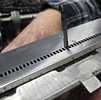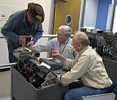Schedule February 2008
return to main 1401 Restoration Page
go to Team Bios
Contents:
Wed Feb 06 - general,
An application of this could be say a hardware store where you the customer pick up cards for items to be picked up
in the bulk storage shed. How do those cards get made? Say the store management wants to punch about 50 cards for
bags of cement, 20 cards for water heaters, ...
Thu Feb 07 - Tape Team
from Allen J Palmer (Fri, Feb 8)
The condition of the SMS cards is very poor. When tracking a ‘bug’ it is frustrating because of the intermittent failures & the lack of reliable replacement cards.
We have very few replacement cards for the TAU. I suggest we strip all the TAU cards from the Visible Storage 1401 and set up a test procedure to test them by type.
Ron Crane & I removed all the MDX cards from the 729 V & he tested them all & repaired those that failed.
To be honest, I would test all the cards in the TAU / 729 using that same process, test all by type.
The only replacement cards for the 729’s is to take one out of the other machines. We need to take cards from the drive in VS, test them & put into our replacement supply.
Defective cards … Defective cards are accumulating and with no one repairing them we are having problems locating problems using ‘card replacement’
If we built a ‘true’ SMS card tester where we could vary voltages & signal levels & shapes it would allow for more detail testing of cards. We had these type of testers when I worked at the Poughkeepsie plant.
It would take some time to build this & test the cards but I believe that in the long run it would save time & lower the frustration level
We have been working on this intermittent ‘backspace’ problem for over a year, many defective cards in the TAU. We have replaced one of the cards in the ‘GO’ latch circuit twice, while finding at least 6 – 8 other defective cards shooting this one problem.
I would like us to have a discussion on this.
Allen
Wed Feb 13 - general
Thu Feb 14 - Tape Team
Wed Feb 20 - general
Thu Feb 21 - Tape Team
Van,
What can you remember about the 'backspace' logic. When we issue a simple
backspace command the drive backspaces then drops the'' backspace logic
level'' but ''go'' remains up resulting in the tape now moving forward in a
run-away mode. We have been through the TAU logic and it looks as though
the write logic level is active (not sure - because latches are 'on' -
'reset off' & then coming up again.
I have rebuilt the prolays, swapped in a different set, and adjusted the
gaps both statically & dynamically. Still getting the old fashion 'bouncy'
start envelope. Swapped the plastic rollers - not change. I took a number of
pictures last Tuesday before and after different adjustments. I will get
them into an email or you to look at. The program we are running is a write,
backspace, read. We can i/e through up to the backspace & the single cycle
through and it fails like clock work.
Allen j Palmer
Allen,
I have been thinking about your problem and it doesn't sound like a drive problem but more like a problem in the TAU backspace logic.
If you can write a bunch of records on tape and rewind it, then read the records with no problem this would point to the TAU. You could even single cycle the read commands to exercise the prolays more.
I am attaching a sequence chart that will help explain backspace. One thing to keep in mind is that any backward command (Backspace, Backspace file or Rewind) after a write command caused a write forward to finish the record gap after the last record written. If you were writing over old data and did not do this you would end up with a 3/8" gap after the last record.
The Backspace command turns on the Backspace latch in the TAU and this starts the delay counter running in millisecond mode. Assuming the tape to be in write status the "Select and write" response from the drive set "Go". A write forward before backspace is now executed. D50 from the delay counter resets "Go" and D96 turns on the "backward latch. This sets backward status and read status in the tape unit. When the delay counter runs to D160, it turns on "Go". The time between D96 and D160 allows the prolays to change to backward status. When the delay counter runs to 180 read condition is turned on to gate the final amplifiers and reset the delay counter. Tape will be moving backward and searching for the check character of the record.
When the check character is read into skew reg. A, the first bit starts the read clock. RC 7 will turn on the RDD latch and start the delay counter. Since this is backspace the RDD will be in milliseconds mode. The delay counter will keep running as the tape moves from the check character to the last character of the record. Since the RDD is in millisecond mode and the conditioning circuits are searching for an RDD 16, there will not be sufficient time to reach it between the check character and the last character of the record. On a 729 II in low density the check character is written 250 us after the last character. RDD 16 represents 600 us or 0.6 ms. When the last character of the record is read into skew reg. A, the first bit starts the RC again. RC 4 resets RDD and RC 7 starts it again. This continues until the first character of the record is read. The RC 7 of the first character starts RDD. Since there are no more characters to be read, the counter runs to RDD 16 which resets read condition and prevents any further information being set into skew registers. At RDD 22 for 729 IV, or RDD 38 for 729 II, the Go latch is reset. By RDD 64 tape has come to a stop and the 64 pulse is used to reset backward. The counter keeps running until RDD 152 when the tape control circuits are reset.
There is a sequence chart of the Backspace 729 operation in the ILD (Intermediate Level Diagrams) Fig. 197. The best thing about this page is it gives you the ALD page of the actual logic cards where you can find pins to connect your scope. With all those fancy scopes out there you shoule be able to capture a good picture of what is actually going on especially since it fails every time on single cycle.
I hope this helps. It may be more than you ever wanted to know. My wife says when someone ask me the time I tell them how to build a clock.
In the previous debug session, we traced the problem to GO being
reactivated at the very end of the Backspace operation.
One more thing, card DGY @ 02B2AD15 should be replaced. It's P output
low level is weak. We replaced the card during the last work session,
but the tape movements became more violent (prolays popping every couple
milliseconds) and it didn't fix the problem, so I put the original card
back in. Once the stuck Write problem is fixed, the new card should not
cause the violent behavior.
Wed Feb 23 - Saturday Drop-in
Wed Feb 27 - general
Thu Feb 28 - Tape Team
From Bob Feretich
TAU Debug Status 2-7-08 (Allen P., Ron W., James D., & me)
Allen installed the capstan drive motors in the tape drive, so we
started the day looking at the Write-Backspace-Read problem that occurs
on the drive.
We switched to testing with the Tape Emulator....
Conclusions:
Regards,
Bob
SMS cards ……….. conditions & replacements
Response from John Van Gardner about image of 513 punch and die
Ed Thelen finally found a suitable job :-)) Janitor - he swept and wet mopped the 1401 restoration area - probably not done
for a year? and used "Simple Green" and a knife to remove many of the rubber marks from the floor.
(Bob Erickson is sensitive to the more exotic solvents we were going to use.) This is Allen in "his
corner" studying - note the clean, relatively mark free floor :-))

Judith caught this picture of Ed mopping

Judith says that she used her video camera to catch Ed on the floor scrubbing with Simple Green.
Some character said that was a waste, a still camera would have caught all the action there was :-(( ;-))
And we just gotta have some fun :-)) Ron Williams attempts to capture an image of Bob Erickson onto the 1403 printer.

Day's end. View of the Entry Way and 1401 room. Stan has connected the printer to the computer system.
We are wondering if this work station could be somewhere else so that our little museum could be returned to this entry way.

Bob Erickson and various folks are building shields for the now working IBM 513 :-))

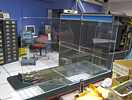
"We" are having an interesting time with trying to make the tapes do a proper backspace.
Some one found a splice in the middle of some reel, and while this is tacky, it is not causing our problem.
Here Glenn is unwinding into the trash can.

We may have had another case of improper loading of cards into the punch side of the 1402 - (They should be
reversed from the read side so that they can merge into the center pocket correctly.) None of the existing
1402s in the museum have labels remaining - they take a beating in service. So we are considering what kind
of label to make.

Here is a label on the input hopper of our 083 sorter.
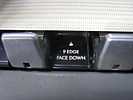
Various Tape Oriented E-Mails
from Allen Palmer - 2/22/2008 6:51 PM
Think about it.
from John Van Gardner - 2/23/2008 9:06 AM
Van Gardner
From Bob Feretich - 2/23/2008 2:31 PM
According to the TAU handbook:
All the above things happen on schedule, however at about 20 msec after
the tape has backed up over the record, Go is turned back on. This is
not supposed to happen.
Our debug from last time involved the Tape Drive being stuck in Write
mode. When a Backspace instruction is executed after a Tape Write
instruction, the Backspace operation has two phases. In the first phase
the tape moves forward erasing the tape to leave a good inter-record
gap (IRG) after the the written record. In the second phase, the drive
is placed in read mode, Backwards is asserted, and the tape is
backed-up to the previous IRG.
Our interface probing showed that the Write latch in the tape drive was
not being reset. Set_Read_Mode was being asserted, and while it was
asserted, Select_Ready_&_Read was active, but
Select_Ready_&_Write stayed active the whole time. (Note that
Set_Read_Mode was not active.) When Set_Read_Mode was released,
Select_Ready_&_Read dropped and Select_Ready_&_Write remained
active.
Probing inside the drive initially confirmed this, but later the
symptoms disappeared. Shortly afterward, the 1401 failed completely,
and we got distracted into fixing that bug.
I believe that Select_Ready_&_Write being active is fooling
the TAU into thinking that it was in the first phase of the
Backspace instruction and that some logic executed the phase 1 to phase
2 transition, when it was supposed to be ending the instruction. Every
odd Delay Counter decode from DC-129 to DC-151 will cause block
B9.60.11.1-3A to set the GO latch.
Trouble shooting should be focused on determining why the drive is
getting stuck in Write Mode. Somewhere in the 729, between the input
relays and the Write Latch, the Set_Write_Mode signal is getting stuck
on.
Regards,
Bob Feretich

PowerUp Sequence Overview

PowerUp Sequence Relay Group
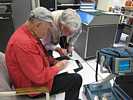
Is that a strange "6" or malformed "8"

Well, there are 4 terminal strips here

135 K byte drawing
OK - lets unplug the 1403 and the 729 tape drive and see what happens
Hey - power now stays up, no problem
Lets work on the tape back space problem.
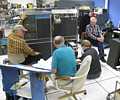
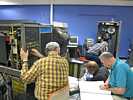
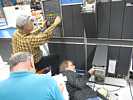
The following is from Bob Feretich
The first part of today's session was lost to a 1401 power problem. The
system kept shutting itself off. The 1403 and 729 were disconnected, and
the problem went away. It did not reoccur when the 1403 and 729 were
reconnected.
The TAU was rewinding tape (slow speed) during the Backspace operation.
We found a problem in the Read_Cond circuit of the TAU. During
Backspace, a 1 usec pulse was arriving to turn on the Read_Cond latch.
Over the last two weeks the latch had grown too slow to be set by the
the pulse. (The circuit was working before.) Since the latch was not
being set, the Read Amplifiers were not being turned on, therefore the
tape would rewind completely while looking for a record. We replaced the
"set" part of this latch and this problem was fixed.
However, we still did not return to the previous problem symptoms. Now
it appears that errors are occurring during Write operations and GO is
not being reset when it should in the second stage of the Backspace
operation.
After we quit for the day, we started to suspect that one of the other
circuits on the quad 2-inp NOR that we replaced may have been bad.
Regards,
Bob Feretich
Today's keypunch gang

Go to March 2008
go to Team Bios

